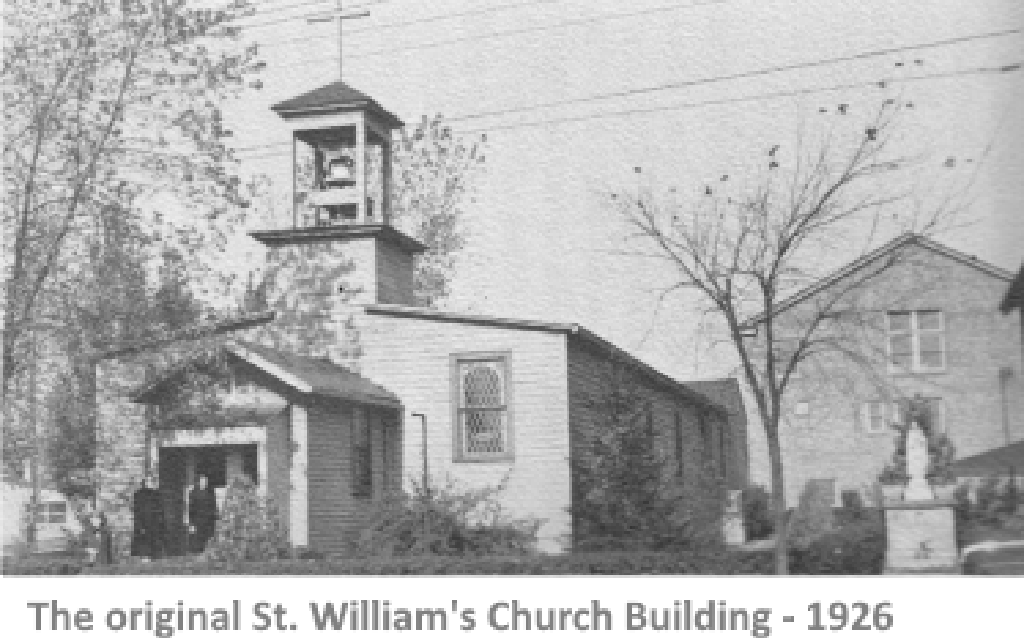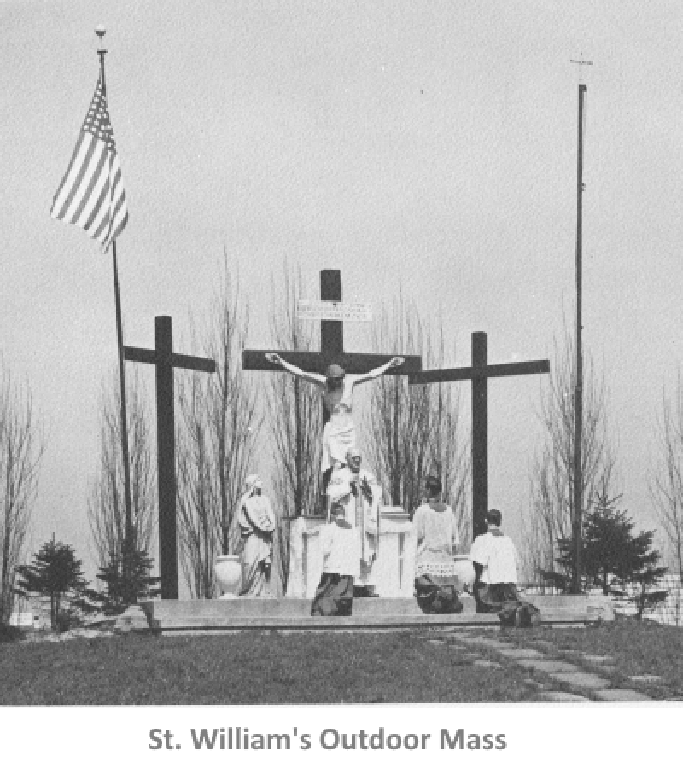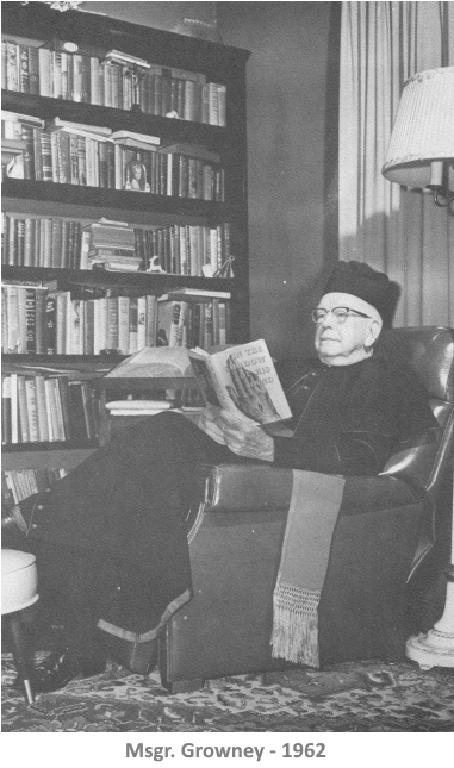A Brief History of St. William Parish
As early as 1920, there was a desire and hope of starting a new parish in the Winchester area of West Seneca. In the summer of 1925 a census was taken by St. John the Baptist Parish and the results revealed that the Catholic children of Winchester had very little instruction in the faith. Reverend William Bernet, pastor of St. John the Evangelist Parish sent Reverend Alfred Hagemier to serve as a catechetical instructor in the Winchester Public School at the home of Mr. and Mrs. Joseph Breidenstein. In 1926, land was purchased at the corner of Harlem Road and Arcade Street for the purpose of erecting a church. The new parish was incorporated as St. William Roman Catholic Church Society with Reverend William Bernet as pastor and Mr. Alexander Switzer and Mr. Joseph Breidenstein as lay trustees.
 At its inception, the Winchester Fire Hall served as a temporary church where parishioners could attend Mass. The first building constructed for the new parish was the rectory which when completed served as a church, meeting space, gathering space for social activities and the living quarters of the resident clergy. Through the generosity of the men of the parish, who donated their time and talent to build the structure, construction quickly proceeded, and the Christmas Eve Midnight Mass was celebrated for the first time in the new rectory-church combination building.
At its inception, the Winchester Fire Hall served as a temporary church where parishioners could attend Mass. The first building constructed for the new parish was the rectory which when completed served as a church, meeting space, gathering space for social activities and the living quarters of the resident clergy. Through the generosity of the men of the parish, who donated their time and talent to build the structure, construction quickly proceeded, and the Christmas Eve Midnight Mass was celebrated for the first time in the new rectory-church combination building.
Father Hagemier continued his energetic and zealous work at St. William with splendid progress until March 1928 when he was transferred to St. Boniface Church. After Father Hagemier’s departure, Reverend Charles Schreckenberger was appointed pastor on March 4, 1928. Shortly afterward, the Winchester Fire Hall was purchased from the Pennsylvania Railroad. The building was moved from Indian Church Road to the west of the rectory and remodeled into a church. The original furnishings which included the pews, altar rail, confessionals and Baptismal font as well as the Mass vestments were donated by Blessed Trinity Church in Buffalo.
On May 14, 1928, ground was broken for St. William’s School and the cornerstone was laid in June 1928. In September of that year, school opened with an enrollment of 25 pupils under the direction of the Sisters of Mercy. The total cost of building the school was $36,939.00.
 Reverend John Hippchen succeeded Father Schreckenberger as pastor in 1929, and he remained at St. William until his death on December 2, 1931. Father Hippchen was sorely beset with the financial problems brought on by the Great Depression of the 1930’s. In 1932, Reverend John Collins was appointed pastor, and for three years, and he struggled to keep St. William’s solvent and open. Despite his efforts and the sacrifices of the people, the new parish sank further into debt. One-third of the wage earners of the 75 families who belonged to St. William was out of work and forced on welfare relief.
Reverend John Hippchen succeeded Father Schreckenberger as pastor in 1929, and he remained at St. William until his death on December 2, 1931. Father Hippchen was sorely beset with the financial problems brought on by the Great Depression of the 1930’s. In 1932, Reverend John Collins was appointed pastor, and for three years, and he struggled to keep St. William’s solvent and open. Despite his efforts and the sacrifices of the people, the new parish sank further into debt. One-third of the wage earners of the 75 families who belonged to St. William was out of work and forced on welfare relief.
In 1935, Reverend James Carter became pastor of St. William, and remained at St. William for barely a year. Sadly, he was forced to close the school in 1936 because he could not afford to heat or maintain the building.
Reverend Francis Growney was appointed temporary administrator of St. William Church in 1936, and many anticipated that the church would close. After six months, Father Growney requested and was granted an extension of his appointment for an additional six months. When his appointment was made it was temporary, and in anticipation that the parish would close. After another six months, Father Growney requested and was granted a second extension of his appointment for an additional six months. Father Growney worked hard to keep the parish open and running as smoothly as possible, as he managed the parish funds wisely.
In 1937, Bishop John A. Duffy began his tenure as Bishop of Buffalo, and he appointed Father Growney pastor of St. William, a position which he retained for 37 years. Under Father Growney’s guidance St. William Parish expanded and flourished as the Great Depression came to an end.
In the late 1930’s and 1940’s, Father Growney became well known for his radio novenas in honor of Our Lady of the Miraculous Medal. He also conducted a radio novena for American service men and women during World War II and was instrumental in counseling and consoling many who served in the Armed Forces.
During the summer of 1937, an outdoor Mass was started for the ill and the aged. An outdoor altar and Mount Calvary Shrine were built on the parish property, the very spot where the Ku Klux Klan burned a cross in 1927. Father Growney was assisted in celebrating the beloved outdoor Masses by Reverend Constantine J. Flizewski and Reverend Joseph Kelly, S.J. These Masses became very popular and attracted thousands of the faithful to attend them.
After considerable effort by many parishioners, St. William School was reopened in 1946 with Sister Mary Claudia, RSM, at the helm.
 In the 1950’s, St. William Parish continued to grow under the guidance of Father Growney, and the need for a new and larger church became evident. Since funds were needed to build a church, a fund drive was begun, donations solicited and with much sacrifice and help from many friends and parishioners, a new church was built. On August 11, 1957, Most Reverend Joseph A. Burke, Bishop of Buffalo, consecrated the new edifice. The Tudor Gothic Limestone church cost $400,000.00 and seats 700 people. The altars are made of Italian Monteverde marble, and the Stations of the Cross are modeled after those in the famous Munich Cathedral in Germany. The stained glass window in the choir is of St. Genesius, the patron saint of actors, and St. Cecilia, the patron saint of music and church organists. St. William Church is a monument of faith and love for God.
In the 1950’s, St. William Parish continued to grow under the guidance of Father Growney, and the need for a new and larger church became evident. Since funds were needed to build a church, a fund drive was begun, donations solicited and with much sacrifice and help from many friends and parishioners, a new church was built. On August 11, 1957, Most Reverend Joseph A. Burke, Bishop of Buffalo, consecrated the new edifice. The Tudor Gothic Limestone church cost $400,000.00 and seats 700 people. The altars are made of Italian Monteverde marble, and the Stations of the Cross are modeled after those in the famous Munich Cathedral in Germany. The stained glass window in the choir is of St. Genesius, the patron saint of actors, and St. Cecilia, the patron saint of music and church organists. St. William Church is a monument of faith and love for God.
Early in 1991, Reverend James L. Breitnauer became Pastor of St. William. He focused on building the faith of the children through good catechetical instruction, believing in the value of a strong Catholic Education. While St. William’s school was closed to full time students, the Religious Education Program was of primary importance to him. As an educator for many years, he loved the challenge of teaching children, and taught religion classes at the parish regularly. Father Breitnauer also loved classical music and encouraged the parish organist and soloists in their ministries. He was instrumental in inviting various musical groups to perform in the church, especially around Christmas time. Members of the parish enjoyed many wonderful performances from gifted musicians and vocalists. Parishioners were shocked and saddened when Father Breitnauer suddenly died on August 22, 1999.
In October, 1999, Reverend Robert Wardenski was appointed Pastor of St. William Parish. Under his guidance and leadership, the parish continued to grow in faith. Father Wardenski remained at St. William until 2005, when he was transferred to Immaculate Conception Parish in East Aurora. Reverend James Bastian was appointed pastor of both St. William and nearby St. Bonaventure Parish for three years, and due to the restructuring plan of the Diocese of Buffalo known as the Journey of Faith and Grace, the parishes were linked. In 2008, Reverend Dennis Wolf was named pastor, and St. William and St. Bonaventure merged into a single worshiping community. The newly merged parish community was renamed Blessed John XXIII Parish until he was canonized a saint on April 27, 2014. The parish was then renamed St. John XXIII parish. Father Wolf remained pastor until his death on November 28, 2014. Following the death of Father Wolfe, Reverend Monsignor Kevin O’Neill was appointed temporary administrator until December 6, 2015, when Reverend John E. Stanton was appointed administrator. He was subsequently appointed pastor on August 24, 2017. Under Father Stanton’s leadership, a regular program of Bible Study and spiritual growth has been initiated as well as physical improvements to the campus.

